Microstructure, Physical and Biological Properties, and BSA Binding Investigation of Electrospun Nanofibers Made of Poly(AA-co-ACMO) Copolymer and Polyurethane
Abstract
:1. Introduction
2. Results and Discussion
2.1. Characterization of Poly(AA-co-ACMO)/PU Nanofibers
2.2. Hydrophilicity Analysis
2.3. Morphology of Poly(AA-co-ACMO)/PU Blend Nanofibers
2.4. Mechanical Properties (Tensile Strength) Measurement
2.5. Thermal Stability of the Composite Nanofibers
2.6. Antibacterial Activity Study
2.7. Mechanistic Investigation of BSA Binding
3. Materials and Methods
3.1. Materials
3.2. Synthesis Poly(AA-co-ACMO) Copolymer
3.3. Fabrication of poly(AA-co-ACMO)/PU (NF11 and NF21)
3.4. Morphology and Characterization of Nanofibers
3.5. Contact Angle Measurement
3.6. Mechanical Measurement
3.7. Antibacterial Ability Test
3.8. BSA Binding Studies
4. Conclusions
Supplementary Materials
Author Contributions
Funding
Institutional Review Board Statement
Informed Consent Statement
Data Availability Statement
Conflicts of Interest
References
- Shah, S.A.; Sohail, M.; Khan, S.; Minhas, M.U.; De Matas, M.; Sikstone, V.; Hussain, Z.; Abbasi, M.; Kousar, M. Biopolymer-based biomaterials for accelerated diabetic wound healing: A critical review. Int. J. Biol. Macromol. 2019, 139, 975–993. [Google Scholar] [CrossRef]
- Silva, L.P.D.; Reis, R.L.; Correlo, V.M.; Marques, A.P. Hydrogel-Based Strategies to Advance Therapies for Chronic Skin Wounds. Annu. Rev. Biomed. Eng. 2019, 21, 145–169. [Google Scholar] [CrossRef] [PubMed]
- Ramos-Gallardo, G. Chronic Wounds in Burn Injury: A Case Report on Importance of Biofilms. World J. Plast. Surg. 2016, 5, 175–180. [Google Scholar]
- Frykberg, R.G.; Banks, J. Challenges in the Treatment of Chronic Wounds. Adv. Wound Care 2015, 4, 560–582. [Google Scholar]
- Liang, Y.; He, J.; Guo, B. Functional Hydrogels as Wound Dressing to Enhance Wound Healing. ACS Nano 2021, 15, 12687–12722. [Google Scholar] [CrossRef]
- Xi, Y.; Ge, J.; Wang, M.; Chen, M.; Niu, W.; Cheng, W.; Xue, Y.; Lin, C.; Lei, B. Bioactive Anti-inflammatory, Antibacterial, Antioxidative Silicon-Based Nanofibrous Dressing Enables Cutaneous Tumor Photothermo-Chemo-Therapy and Infection Induced Wound Healing. ACS Nano 2020, 14, 2904–2916. [Google Scholar] [CrossRef] [PubMed]
- Wang, M.; Niu, W.; Chen, M.; Cheng, W.; Zhang, L.; Xie, C.; Wang, Y.; Guo, Y.; Leng, T.; Zhang, X.; et al. Injectable self-healing anti-inflammatory europium oxide-based dressing with high angiogenesis for improving wound healing and skin regeneration. Chem. Eng. J. 2021, 412, 128471–128479. [Google Scholar]
- Ousey, K.; Cutting, K.F.; Rogers, A.A.; Rippon, M.G. The importance of hydration in wound healing: Reinvigorating the clinical perspective. J. Wound Care 2016, 25, 122–130. [Google Scholar] [CrossRef]
- Lustig, A.; Gefen, A. Three-dimensional shape-conformation performances of wound dressings tested in a robotic sacral pressure ulcer phantom. Int. Wound J. 2021, 18, 670–680. [Google Scholar] [CrossRef]
- Ashkezari, M.M.; Shokrollahi, P.; Zandi, Z.; Shokrolahi, F. Polyurethanes with separately tunable biodegradation behaviorand mechanical properties for tissue engineering. Polym. Adv. Technol. 2018, 2, 528–541. [Google Scholar]
- Efe, H.; Bicen, M.; Kahraman, M.V.; Kayaman-Apohan, N. Synthesis of 4-Acryloylmorpholine-based Hydrogels and Investigation of their Drug Release Behaviors. J. Braz. Chem. Soc. 2013, 24, 814–820. [Google Scholar] [CrossRef]
- Schiavon, O.; Caliceti, P.; Ferruti, P.; Veronese, F.M. Therapeutic proteins: A comparison of chemical and biological properties of uricase conjugated to linear or branched poly(ethylene glycol) and poly(N-acryloylmorpholine). Il Farmaco 2000, 55, 264–269. [Google Scholar] [CrossRef] [PubMed]
- Jo, Y.K.; Vlies, A.J.V.; Gantz, J.; Antonijevic, S.; Demurtas, D.; Velluto, D.; Hubbell, J.A. RAFT homo- and copolymerization of N-acryloyl-morpholine, piperidine, and azocane and their self-assembled structures. Macromolecules 2008, 41, 1140–1150. [Google Scholar] [CrossRef]
- Torchilin, V.P.; Shtilman, M.I.; Trubetskoy, V.S.; Whiteman, K.; Milstein, A.M. Amphiphilic vinyl polymers effectively prolong liposome circulation time in vivo. Biochim. Biophys. Acta 1994, 1195, 181–184. [Google Scholar] [CrossRef] [PubMed]
- Fares, M.M.; Al-Shboul, A.M. Stimuli pH-responsive (N-vinylimidazole-co-acryloylmorpholine) hydrogels; mesoporous and nanoporous scaffolds. J. Biomed. Mater. Res. Part A 2010, 100, 863–871. [Google Scholar]
- Takahashi, H.; Nakayama, M.; Shimizu, S.; Yamato, M.; Okano, T. Anisotropic cell sheets for constructing three-dimensional tissue with well-organized cell orientation. Biomaterials 2011, 32, 8830–8838. [Google Scholar] [CrossRef]
- Takahashi, H.; Nakayama, M.; Itoga, K.; Yamato, M.; Okano, T. Micropatterned thermoresponsive polymer brush surfaces for fabricating cell sheets with well-controlled orientational structures. Biomacromolecules 2011, 12, 1414–1418. [Google Scholar] [CrossRef]
- Kruk, T.; Bzowska, M.; Hinz, A.; Szuwarzyński, M.; Szczepanowicz, K. Control of Specific/Nonspecific Protein Adsorption: Functionalization of Polyelectrolyte Multilayer Films as a Potential Coating for Biosensors. Materials 2021, 14, 7629. [Google Scholar] [CrossRef]
- Greiner, A.; Wendorff, H. Electrospinning: A fascinating method for the preparation of ultrathin fibers. Angew. Chem. Int. Ed. 2007, 46, 5670–5673. [Google Scholar] [CrossRef]
- Lin, S.; Cai, Q.; Ji, J.; Sui, G.; Yu, Y.; Yang, X. Electrospun nanofiber reinforced and toughened composites through in situ nano-interface formation. J. Compos. Sci. Technol. 2008, 68, 3322–3329. [Google Scholar] [CrossRef]
- Park, S.J.; Chase, G.G.; Jeong, K.; Kim, H.Y. Mechanical properties of titania nanofiber mats fabricated by electrospinning of sol–gel precursor. J. Sol.-Gel. Sci. Technol. 2010, 54, 188–194. [Google Scholar] [CrossRef]
- Sekak, A.; Lowe, A. Structural and Thermal Characterization of Calcium Cobaltite Electrospun Nanostructured Fibers. J. Am. Ceram. Soc. 2011, 94, 611–619. [Google Scholar] [CrossRef]
- Yu, H.; Xu, Y.; Havener, K.; Zhang, M.; Zhang, L.; Wu, W.; Huang, K. Temperature-Controlled Selectivity of Hydrogenation and Hydrodeoxygenation of Biomass by Superhydrophilic Nitrogen/Oxygen Co-Doped Porous Carbon Nanosphere Supported Pd Nanoparticles. Small 2022, 18, 2106893–2106903. [Google Scholar] [CrossRef] [PubMed]
- Yu, H.; Zhang, L.; Gao, S.; Wanga, H.; He, Z.; Xu, Y.; Huang, K. In situ encapsulated ultrafine Pd nanoparticles in nitrogen-doped porous carbon derived from hyper-crosslinked polymers effectively catalyse hydrogenation. J. Catal. 2021, 396, 342–350. [Google Scholar]
- Zhu, J.; Wei, S.; Rutman, D.; Haldolaarachchige, N.; Young, D.; Guo, Z. Magnetic polyacrylonitrile-Fe@FeO nanocomposite fibers—Electrospinning, stabilization and carbonization. J. Polym. 2011, 52, 2947–2955. [Google Scholar] [CrossRef]
- Zhu, J.; Wei, S.; Patil, R.; Rutman, D.; Kucknoor, S.; Wang, A.; Guo, Z. Ionic liquid assisted electrospinning of quantum dots/elastomer composite nanofibers. J. Polym. 2011, 52, 1954–1962. [Google Scholar] [CrossRef]
- Chen, X.; Wei, S.; Gunesoglu, C.; Zhu, J.; Southworth, S.; Sun, L. Electrospin Magnetic Fibrillar Polystyrene Nanocomposites Reinforced with Nickel Nanoparticles. J. Macromol. Chem. Phys. 2010, 211, 1775–1783. [Google Scholar] [CrossRef]
- Zhang, D.; Karki, A.; Rutman, D.; Young, D.; Wang, A.; Cocke, D.; Ho, T.; Guo, Z. Electrospin polyacrylonitrile nanocomposite fibers reinforced with Fe3O4 nanoparticles: Fabrication and property analysis. J. Polym. 2009, 50, 4189–4198. [Google Scholar] [CrossRef]
- Sainia, B.; Khuntiab, S.; Sinha, M.K. Incorporation of cross-linked poly(AA-co-ACMO) copolymer with pH responsive and hydrophilic properties to polysulfone ultrafiltration membrane for the mitigation of fouling behavior. J. Membr. Sci. 2019, 572, 184–197. [Google Scholar] [CrossRef]
- El-Refaie, K.; Gary, L.; Kevin, M.; John, L.; David, S.; Elliot, H.; Gary, W. Release of tetracycline hydrochloride from electrospun poly(ethylene-co-vinylacetate), poly(lactic acid), and a blend. J. Control Rel. 2002, 81, 57–64. [Google Scholar]
- Arefin, J.H.A.; Huang, D.; Platts, V.D.; Hypes, J.F.; Harris, R.; Iyer, P.N. Fabrication of flexible thin polyurethane membrane for tissue engineering applications. Biomed. Microdevices 2017, 19, 98–106. [Google Scholar] [CrossRef]
- Li, Y.H.; Li, N.; Pan, W.; Yu, Z.Z.; Yang, L.M.; Tang, B. Hollow mesoporous silica nanoparticles with tunable structures for controlled drug delivery. ACS Appl. Mater. Interfaces 2017, 9, 2123–2129. [Google Scholar] [CrossRef] [PubMed]
- Yi, J.Z.; Goh, S.H. Interactions in miscible blends and complexes of poly(N-acryloylmorpholine) with poly(p-vinylphenol). Polymer 2002, 43, 4515–4522. [Google Scholar] [CrossRef]
- Li, D.; Lin, J.; An, Z.; Li, Y.; Zhu, X.; Yang, J.; Wang, Q.; Zhao, J.; Zhao, Y.; Chen, L. Enhancing hydrophilicity and comprehensive antifouling properties of microfiltration membrane by novel hyperbranched poly(N-acryoylmorpholine) coating for oil-in-water emulsion separation. React. Funct. Polym. 2020, 156, 104735. [Google Scholar] [CrossRef]
- Suryawanshi, V.D.; Anbhule, P.V.; Gore, A.H. Spectroscopic investigationon the interaction of pyrimidine derivative, 2-amino-6-hydroxy-4-(3,4-di-methoxyphenyl)-pyrimidine-5-carbonitrile with human serum albumin: Mechanistic and conformational study. Ind. Eng. Chem. Res. 2012, 51, 95–102. [Google Scholar] [CrossRef]
- Peters, T. All about Albumin: Biochemistry, Genetics and Medical Application; Academic Press: New York, NY, USA, 1996. [Google Scholar]
- Shaban, N.Z.; Yehia, S.A.; Shoueir, K.R.; Saleh, S.R.; Awad, D.; Shaban, S.Y. Design, DNA binding, and kinetic studies, antibacterial and cytotoxic activities of stable dithiophenolato titanium(IV)-chitosan Nanocomposite. J. Mol. Liq. 2019, 287, 111002. [Google Scholar] [CrossRef]
- Shaban, N.Z.; Aboelsaad, A.M.; Shoueir, K.R.; Abdulmalek, S.A.; Awad, D.; Shaban, S.Y. Chitosan-based dithiophenolato nanoparticles: Preparation, mechanistic information of DNA binding, antibacterial and cytotoxic activities. J. Mol. Liq. 2020, 318, 114252. [Google Scholar] [CrossRef]
- Elshami, F.I.; Ramadan, A.M.; Ibrahim, M.M.; Elmehasseb, I.M.; Al-Juaid, S.; Shaban, S.Y. Metformin Containing Nickel (II) Complexes: Synthesis, Structural Characterization, Binding and Kinetic Interactions with BSA, Antibacterial and in-vitro Cytotoxicity Studies. Appl. Organometal. Chem. 2019, 34, 5437. [Google Scholar] [CrossRef]
- Shereef, H.A.; Shaban, S.Y.; Moemen, Y.S.; El-Khouly, M.E.; El-Nahas, A.M. Biophysicochemical studies of a ruthenium (II) nitrosyl thioether-thiolate complex binding to BSA: Mechanistic information, molecular docking, and relationship to antibacterial and cytotoxic activities. Appl. Organomet. Chem. 2022, 35, 6583. [Google Scholar] [CrossRef]
- Lin, X.; Tang, D.; Yua, Z.; Feng, Q. Stimuli-responsive electrospun nanofibers from poly(N-isopropylacrylamide)-co- poly(acrylic acid) copolymer and polyurethane. J. Mater. Chem. B 2014, 2, 651. [Google Scholar] [CrossRef]
- Badri, K.; Sien, W.; Shahrom, M.; Hao, L.; Baderuliksan, N.; Norzali, N. FTIR spectroscopy analysis of the prepolymerization of palm-based polyurethane. Solid State Sci. Technol. 2010, 18, 1–8. [Google Scholar]
- Packham, D.E. Physiochemical aspects of polymer surfaces. In International Journal of Adhesion and Adhesive; Mittal, K.L., Ed.; Plenum Press: New York, NY, USA, 1983; pp. 583–594. [Google Scholar]
- Choma, J.; Jamioła, D.; Augustynek, K.; Marszewski, M.; Jaroniec, M. Carbon–gold core–shell structures: Formation of shells consisting of gold nanoparticles. Chem. Commun. 2012, 48, 3972–3974. [Google Scholar] [CrossRef] [PubMed]
- Huang, Y.-J.; Huang, C.-L.; Lai, R.-Y.; Zhuang, C.-H.; Chiu, W.-H.; Lee, K.-M. Microstructure and Biological Properties of Electrospun In Situ Polymerization of Polycaprolactone-Graft-Polyacrylic Acid Nanofibers and Its Composite Nanofiber Dressings. Polymers 2021, 13, 4246. [Google Scholar] [CrossRef] [PubMed]
- Huang, Y.; Lu, J.; Xiao, C. Thermal and mechanical properties of cationic guar gum/poly(acrylic acid) hydrogel membranes. Polym. Degrad. Stab. 2007, 92, 1072. [Google Scholar] [CrossRef]
- Drury, J.L.; Dennis, R.G.; Mooney, D.J. The tensile properties of alginate hydrogels. Biomaterials 2004, 25, 3187. [Google Scholar] [CrossRef] [PubMed]
- Smart, S.K.; Cassady, A.I.; Lu, G.Q.; Martin, D.J. The biocompatibility of carbon nanotubes. Carbon 2006, 44, 1034–1047. [Google Scholar] [CrossRef]
- Liu, Z.; Yang, Z.; Luo, Y. Swelling, pH Sensitivity, and Mechanical Properties of Poly(acrylamide-co-sodium methacrylate) Nanocomposite Hydrogels Impregnated with Carboxyl-Functionalized Carbon Nanotubes. Polym. Compos. 2012, 33, 665–674. [Google Scholar] [CrossRef]
- Spinks, G.M.; Mottaghitalab, V.; Barhrami-Samani, M.; Whitten, P.G.; Wallace, G.G. Carbon-Nanotube-Reinforced Polyaniline Fibers for High-Strength Artificial Muscles. Adv. Mater. 2006, 18, 637. [Google Scholar] [CrossRef]
- Xie, W.; Xu, P.; Wang, W.; Liu, Q. Preparation and antibacterial activity of a water-soluble chitosan derivative. Carbohydr. Polym. 2002, 50, 35–40. [Google Scholar] [CrossRef]
- Denny, W.A.; Wakelin, L.P. Kinetic and equilibrium studies of the interaction of amsacrine and anilino ring-substituted analogues with DNA. Cancer Res. 1986, 46, 1717–1721. [Google Scholar]
- Tomon, T.; Koizumi, T.; Tanaka, K. Electrochemical hydrogenation of [Ru(bpy)2(napy-kappaN)(CO)]2+: Inhibition of reductive Ru-CO bond cleavage by a ruthenacycle. Angew. Chem. Int. Ed. 2005, 44, 2229–2232. [Google Scholar] [CrossRef]
- Devi, V.S.; Chidi, O.O.; Coleman, D. Dominant effect of ethanol in thermal destabilization of bovine serum albumin in the presence of sucrose. Spectroscopy 2009, 23, 265–270. [Google Scholar] [CrossRef]
- Chen, C.-K.; Lee, M.-C.; Lin, Z.-I.; Lee, C.-A.; Tung, Y.-C.; Lou, C.-W.; Law, W.-C.; Chen, N.-T.; Lin, K.-Y.A.; Lin, J.-H. Intensifying the Antimicrobial Activity of Poly [2-(tert-butylamino)ethyl Methacrylate]/Polylactide Composites by Tailoring Their Chemical and Physical Structures. Mol. Pharm. 2019, 16, 709–723. [Google Scholar] [CrossRef] [PubMed]
- Beer, J.; Wagner, C.C.; Zeitlinger, M. Protein Binding of Antimicrobials: Methods for Quantification and for Investigation of its Impact on Bacterial Killing. AAPS J. 2009, 11, 1–12. [Google Scholar] [CrossRef] [PubMed]
- Wright, J.D.; Boudinot, F.D.; Ujhelyi, M.R. Measurement and analysis of unbound drug concentrations. Clin. Pharmacokinet. 1996, 30, 445–462. [Google Scholar] [CrossRef] [PubMed]
- Yano, Y.; Oguma, T.; Nagata, H.; Sasaki, S. Application of logistic growth model to pharmacodynamic analysis of in vitro bactericidal kinetics. J. Pharm. Sci. 1998, 87, 1177–1183. [Google Scholar] [CrossRef]
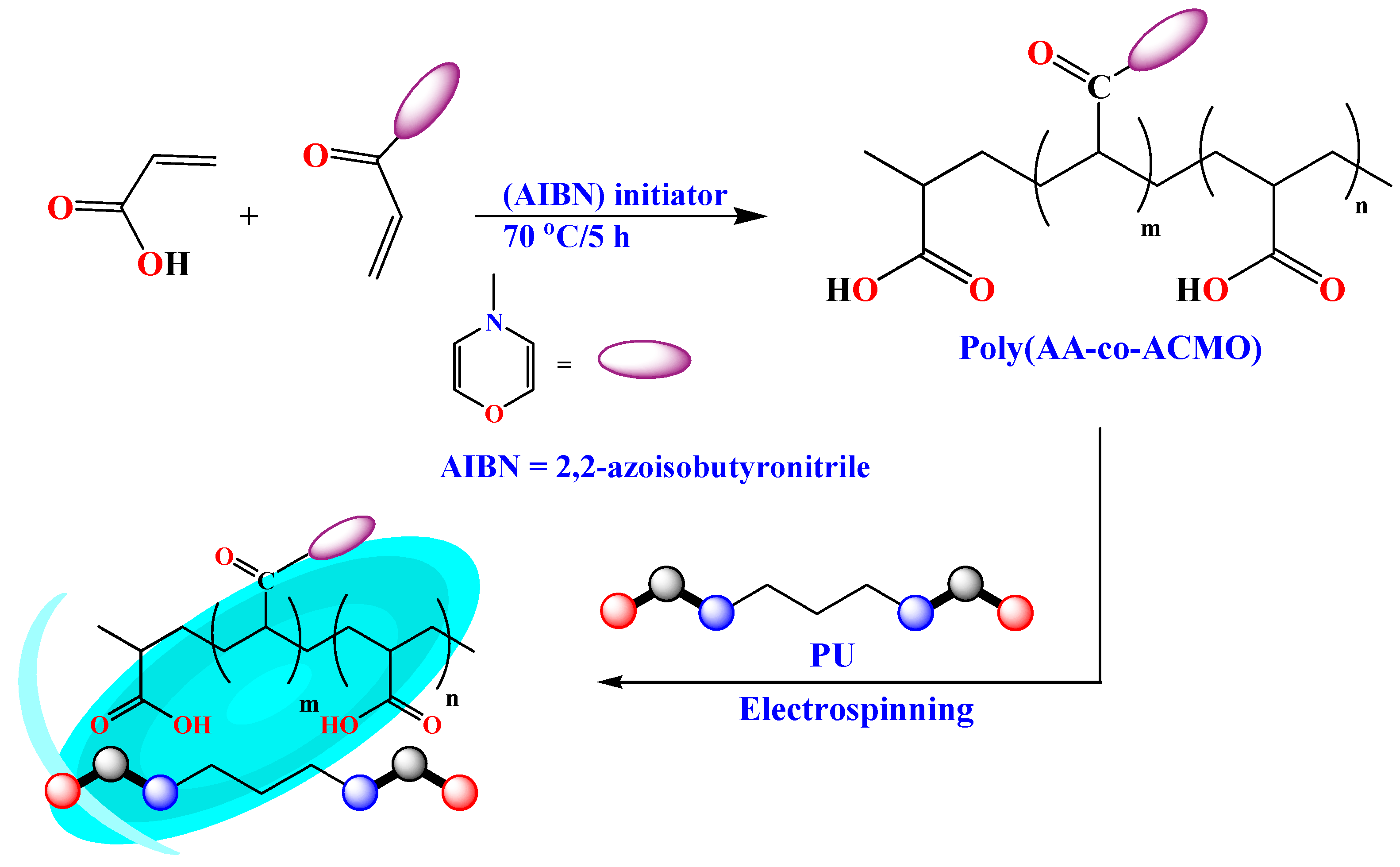

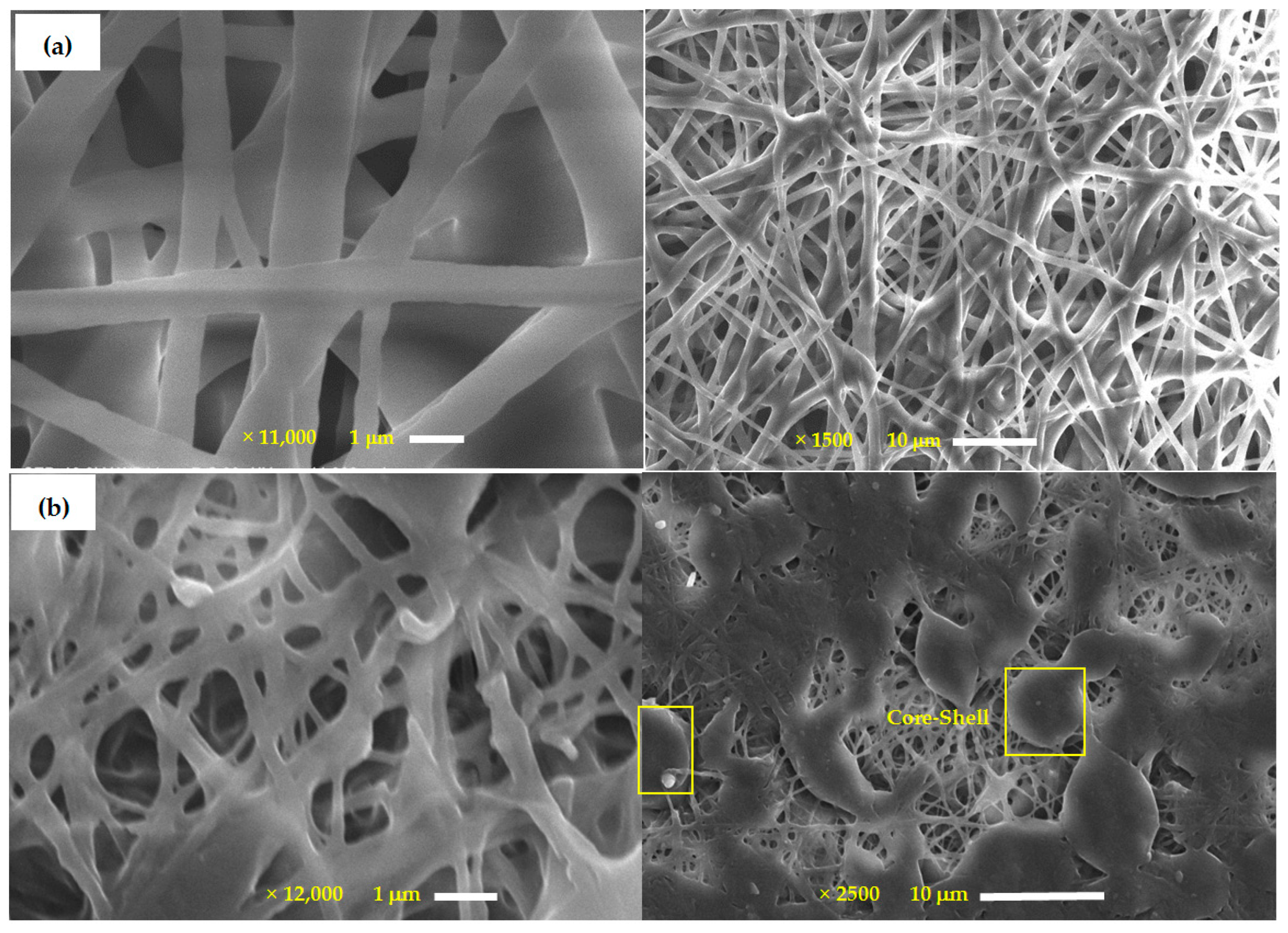
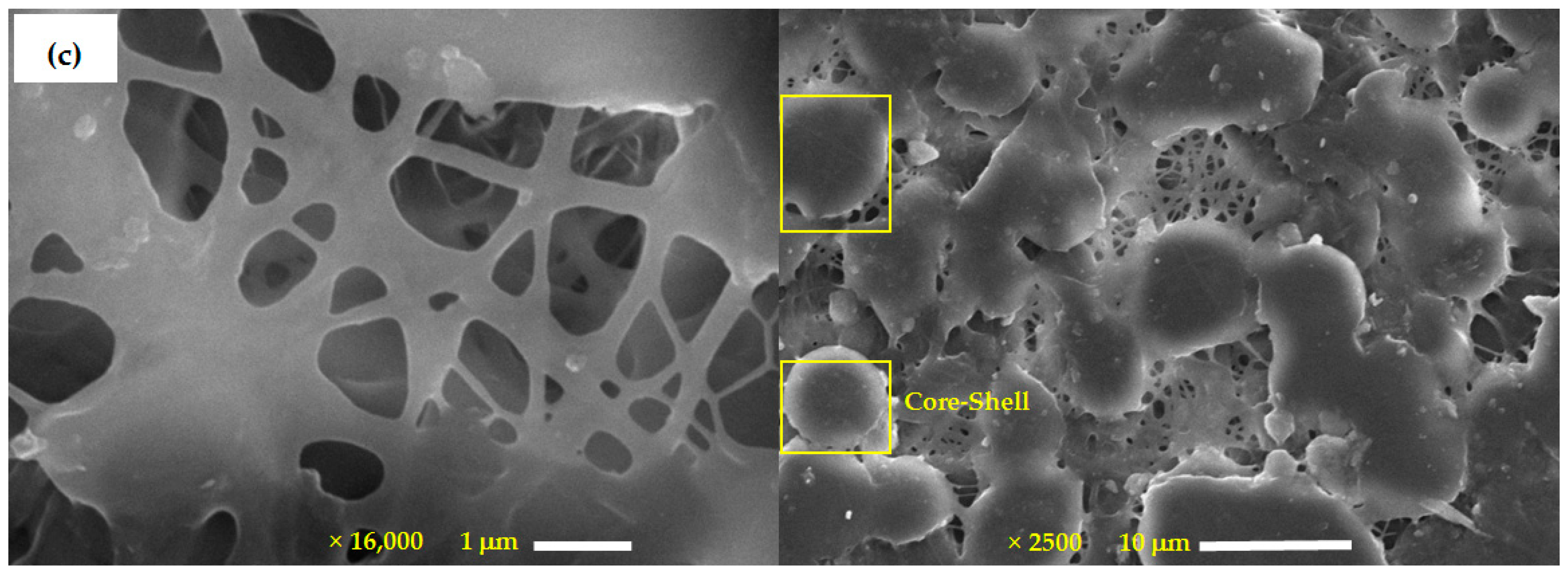
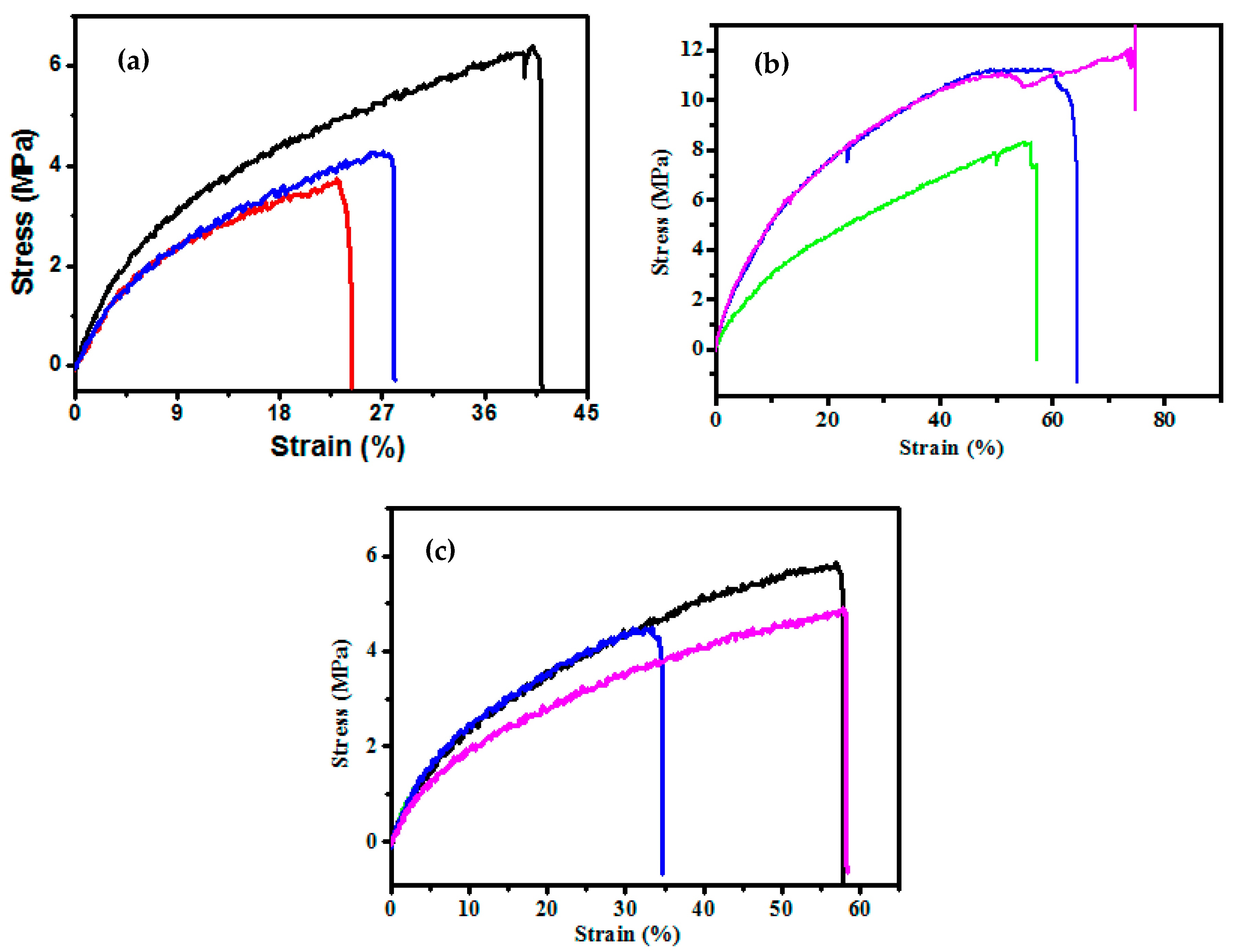
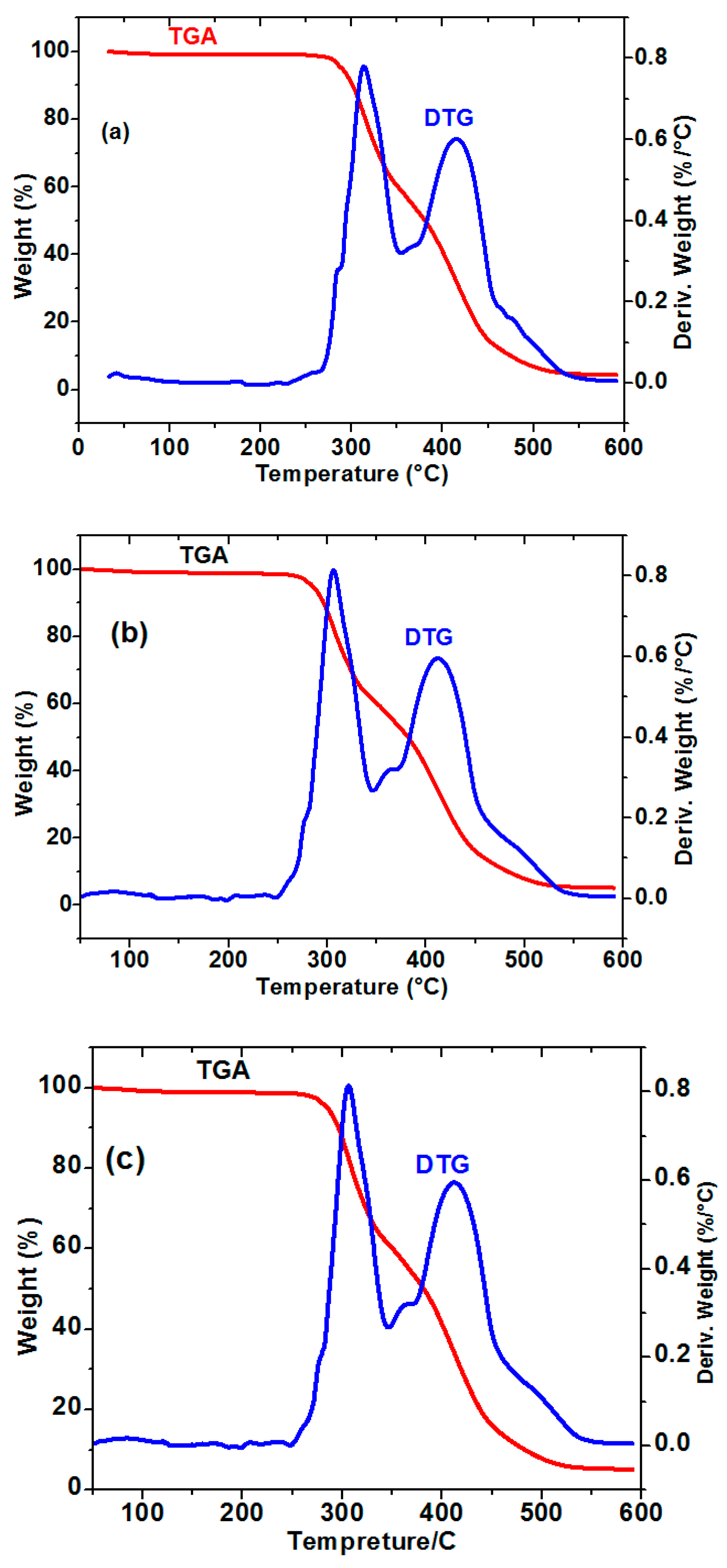
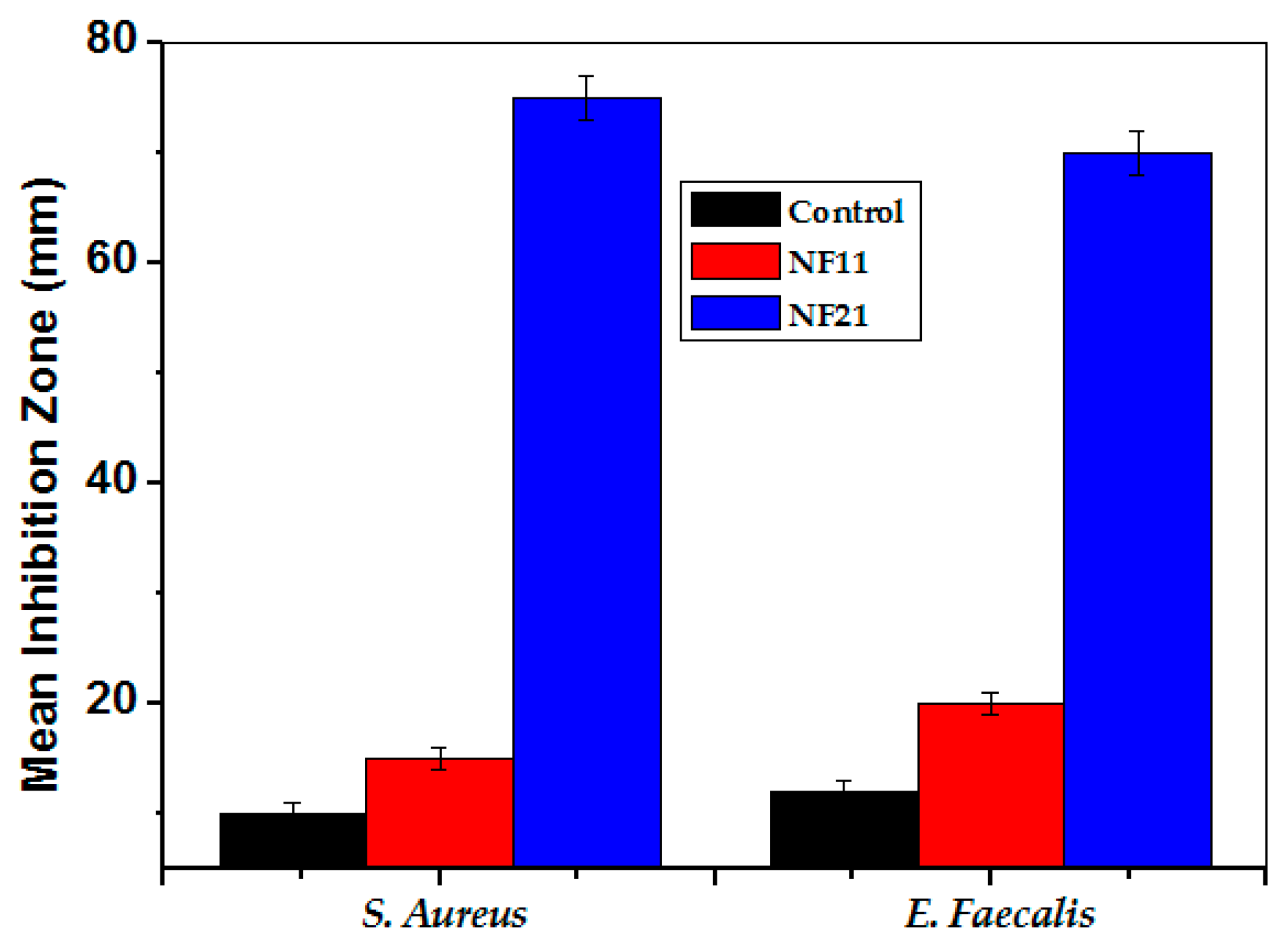


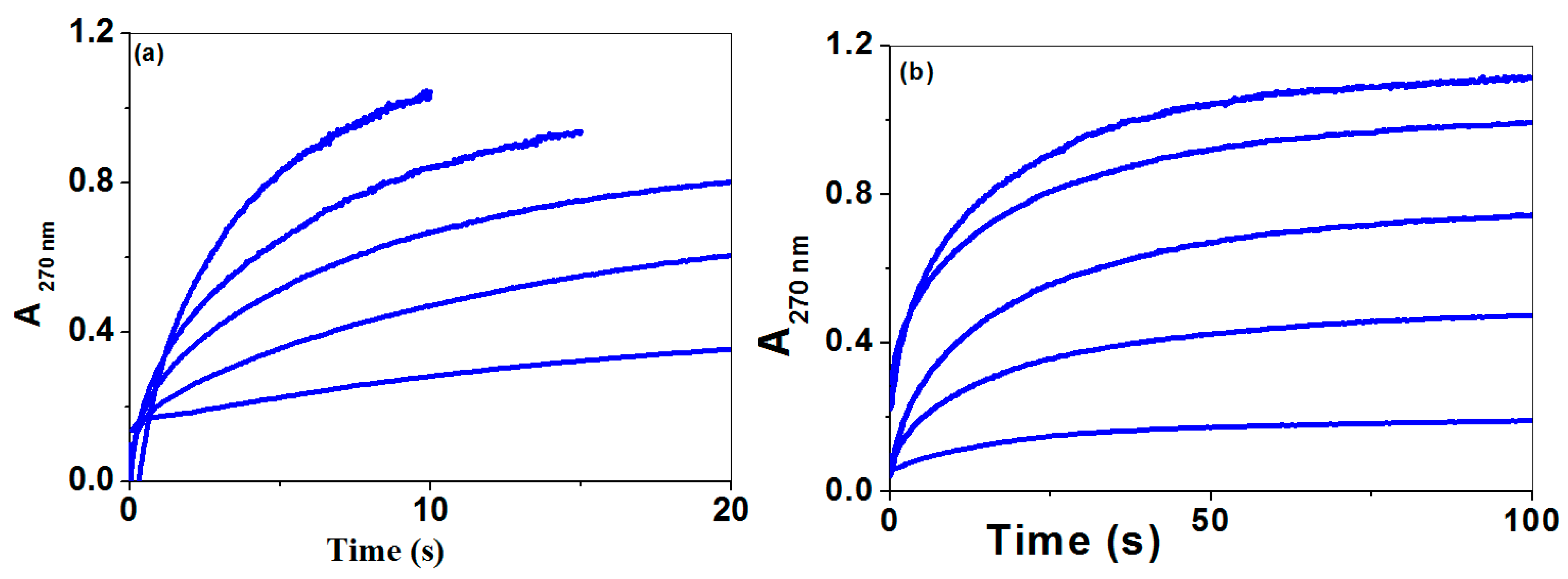
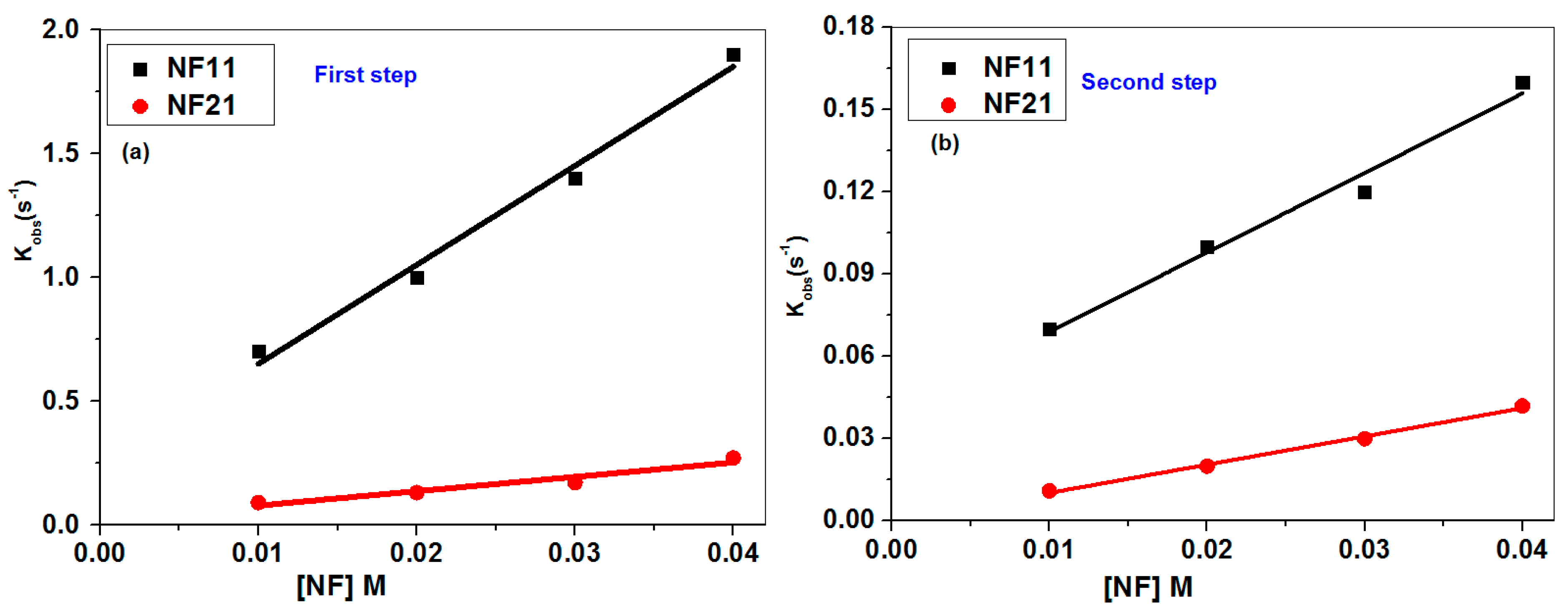
| Sample | PU | NF11 | NF21 |
|---|---|---|---|
| Water contact angle (°) | 137.0 ± 4.0 | 95.0 ± 6.0 | 24.0 ± 1.5 |
| Tensile strength (MPa) | 5.2 ± 0.3 | 15.8 ± 1.0 | 8.5 ± 1.1 |
| Young’s modulus (MPa) | 8.4 ± 0.6 | 46.0 ± 2.1 | 20.0 ± 2.3 |
| Strain break (%) | 3.4 ± 0.2 | 9.2 ± 1.2 | 6.7 ± 0.9 |
| Activation Parameters | NF11 | NF21 | |
|---|---|---|---|
| First interaction step | k1 [M−1 s−1] | 45.7 ± 4.5 | 6.2 ± 0.4 |
| k−1 [10−3 s−1] | 257.0 ± 13.6 | 7.5 ± 1.3 | |
| Ka1 [M−1] | 177.8 | 826.6 | |
| Kd1 [10−3 M] | 6.0 | 1.0 | |
| ΔG1# [kJ mol−1] | −12.6 | −17.1 | |
| Second interaction step | K2 [M−1 s−1] | 2.9 ± 0.2 | 1.9 ± 0.1 |
| k−2 [10−3 s−1] | 44.0 ± 1.0 | 1.0 ± 0.1 | |
| Ka2 [M−1] | 66 | 1900 | |
| Kd2 [10−3 M] | 15.0 | 0.5 | |
| ΔG2# [kJ mol−1] | −6.7 | −18.7 | |
| Overall interaction data | Kd [10−6 M] | 89 | 5.3 |
| Ka [104 M] | 1.1 | 189 | |
| ΔG# [kJ mol−1] | −23.1 | −27.5 |
Disclaimer/Publisher’s Note: The statements, opinions and data contained in all publications are solely those of the individual author(s) and contributor(s) and not of MDPI and/or the editor(s). MDPI and/or the editor(s) disclaim responsibility for any injury to people or property resulting from any ideas, methods, instructions or products referred to in the content. |
© 2023 by the authors. Licensee MDPI, Basel, Switzerland. This article is an open access article distributed under the terms and conditions of the Creative Commons Attribution (CC BY) license (https://creativecommons.org/licenses/by/4.0/).
Share and Cite
Mansour, H.; Elsigeny, S.M.; Elshami, F.I.; Auf, M.; Shaban, S.Y.; van Eldik, R. Microstructure, Physical and Biological Properties, and BSA Binding Investigation of Electrospun Nanofibers Made of Poly(AA-co-ACMO) Copolymer and Polyurethane. Molecules 2023, 28, 3951. https://doi.org/10.3390/molecules28093951
Mansour H, Elsigeny SM, Elshami FI, Auf M, Shaban SY, van Eldik R. Microstructure, Physical and Biological Properties, and BSA Binding Investigation of Electrospun Nanofibers Made of Poly(AA-co-ACMO) Copolymer and Polyurethane. Molecules. 2023; 28(9):3951. https://doi.org/10.3390/molecules28093951
Chicago/Turabian StyleMansour, Hanaa, Samia M. Elsigeny, Fawzia I. Elshami, Mohamed Auf, Shaban Y. Shaban, and Rudi van Eldik. 2023. "Microstructure, Physical and Biological Properties, and BSA Binding Investigation of Electrospun Nanofibers Made of Poly(AA-co-ACMO) Copolymer and Polyurethane" Molecules 28, no. 9: 3951. https://doi.org/10.3390/molecules28093951
APA StyleMansour, H., Elsigeny, S. M., Elshami, F. I., Auf, M., Shaban, S. Y., & van Eldik, R. (2023). Microstructure, Physical and Biological Properties, and BSA Binding Investigation of Electrospun Nanofibers Made of Poly(AA-co-ACMO) Copolymer and Polyurethane. Molecules, 28(9), 3951. https://doi.org/10.3390/molecules28093951








